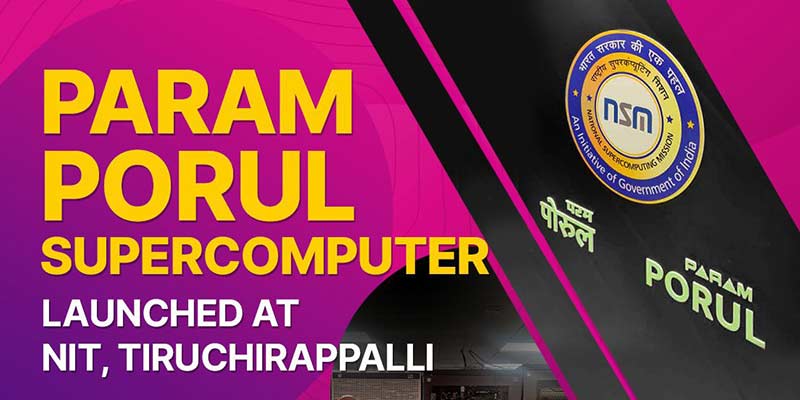- India
- May 26
NIT-T commissions Param Porul supercomputer
• Param Porul, a state-of-the-art supercomputer, was inaugurated at National Institute of Technology, Tiruchirappalli under National Supercomputing Mission (NSM).
• It is a joint initiative of the ministry of electronics and information technology (MeitY) and department of science and technology (DST).
• An MoU was signed between NIT Tiruchirappalli and Centre for Development in Advanced Computing (C-DAC) in October 2020 to establish this 838 TeraFlops supercomputing facility under NSM.
• Under NSM, 15 supercomputers have been installed across the nation.
Features of Param Porul
• Param Porul supercomputing facility is established under Phase 2 of the NSM, where in majority of the components used to build this system have been manufactured and assembled within the country, along with an indigenous software stack developed by C-DAC, in line with the ‘Make in India’ initiative.
• The system is equipped with high performance InfiniBand interconnect to cater the computing needs of various scientific and engineering applications.
• The system is based on Direct Contact Liquid Cooling technology to obtain a high power usage effectiveness and thereby reducing the operational cost.
• Multiple applications from various scientific domains such as weather and climate, bioinformatics, computational chemistry, molecular dynamics, material sciences, computational fluid dynamics, etc have been installed on the system for the benefit of researchers.
• NIT has been carrying out research in the areas of societal interest such as health, agriculture, weather and financial services.
• The facility installed under NSM will strengthen this research. The new high-performance computational facility would aid researchers to solve large-scale problems of different fields of science and engineering.
National Supercomputing Mission (NSM)
• In 2015, the Cabinet Committee on Economic Affairs approved the launch of the National Supercomputing Mission (NSM) at an estimated cost of Rs 4,500 crore over a period of seven years.
• The Mission envisages empowering our national academic and R&D institutions by installing a vast supercomputing grid comprising more than 70 high-performance computing facilities. These supercomputers will also be networked on the national supercomputing grid over the National Knowledge Network (NKN).
• The NKN is another programme of the government which connects academic institutions and R&D labs over a high speed network.
• Academic and R&D institutions as well as key user departments/ministries would participate by using these facilities and develop applications of national relevance.
• The Mission is being jointly steered by the department of science and technology (DST) and the ministry of electronics and information technology (MeitY) and implemented by the Centre for Development of Advanced Computing (C-DAC), Pune, and the Indian Institute of Science (IISc), Bengaluru.
• NSM was set up to provide the country with supercomputing infrastructure to meet the increasing computational demands of academia, researchers, MSMEs, and startups by creating the capability design, manufacturing, of supercomputers indigenously in India.
• The Mission implementation would bring supercomputing within the reach of the large scientific and technology community in the country and enable the country with a capacity of solving multi-disciplinary grand challenge problems.
Objectives of NSM:
1) To make India one of the world leaders in supercomputing and to enhance India’s capability in solving grand challenge problems of national and global relevance.
2) To empower our scientists and researchers with state-of-the-art supercomputing facilities and enable them to carry out cutting-edge research in their respective domains.
3) To minimise redundancies and duplication of efforts, and optimise investments in supercomputing.
4) To attain global competitiveness and ensure self-reliance in the strategic area of supercomputing technology.
Manorama Yearbook app is now available on Google Play Store and iOS App Store

